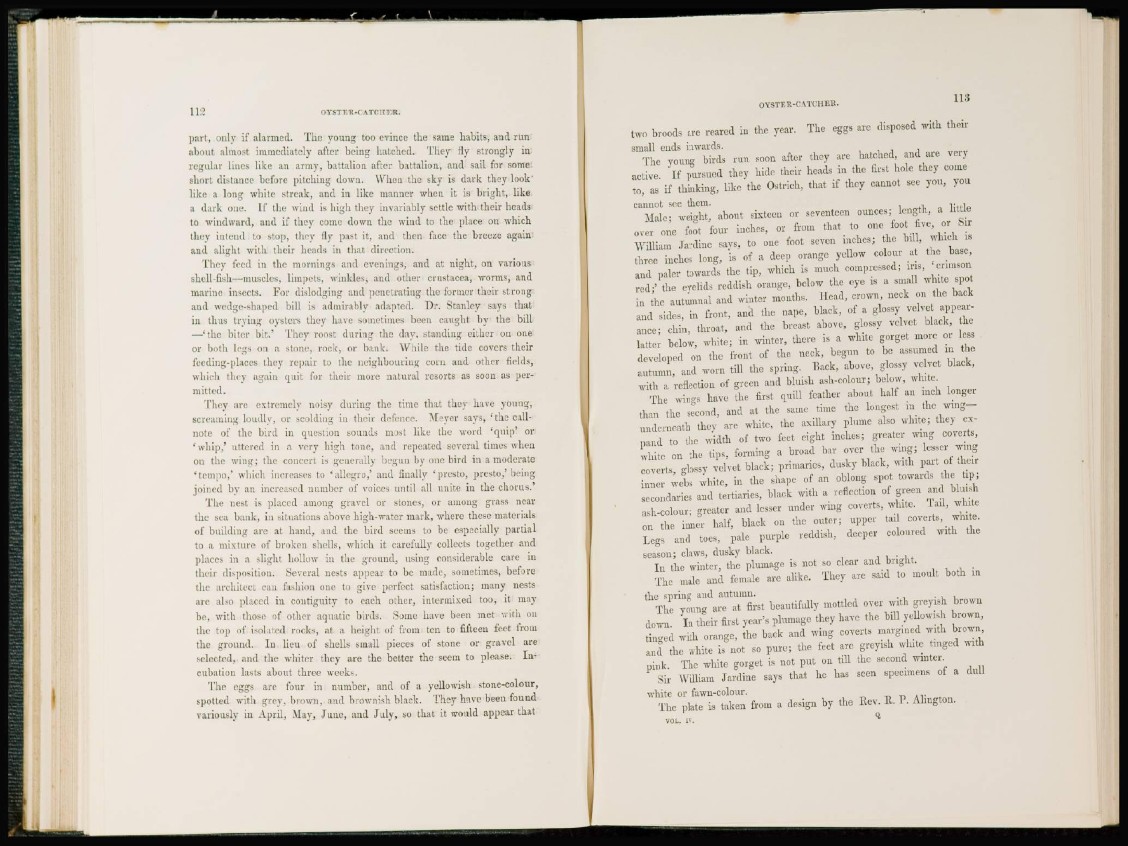
112 OYSTT,Tl-('ATnn;R.
pari, only if alarmed. TRIE young too evince the same habits, and run
about almost immediately after being hatched. They fly strongly in
regular lines like an army, battalion after battalion, and sail for some
short distance before pitching down. When the sky is dark they look
like a long white streak, and in like manner when it is bright, like
a dark one. If the wind is high they invariably settle with their heads
to windward, and if they come down the wind to the place on which
they intend to stop, they fly past it, and then face the breeze again
and alight with their heads in that direction.
They feed in the mornings and evenings, and at night, on various
shell-fish—muscles, limpets, winkles, and other Crustacea, worms, and
marine insects. For dislodging and penetrating the former their strong
and wedge-shaped bill is admiral)!v adapted. Dr. Stanley says that
in thus toying oysters they have sometimes been caught by the bill
— ' t h e biter bit.' They roost during the day, standing either on one
or both legs on a stone, rock, or hank. While the tide covers their
feeding-places they repair to the neighbouring corn and other fields,
which they again quit for their more natural resorts as soon as permitted.
They arc extremely noisy during the time that they have young,
screaming loudly, or scolding in their defence. .Meyer says, ' the callnote
of the bird in question sounds most like the word 'quip' or
' w h i p / uttered in a very high tone, and repeated several times when
on the wing; the concert is generally begun by one bird in a moderate
* tempo,* which increases to 'allegro,' and finally ' presto, presto,' being
joined by an increased number of voices until all unite in the chorus.'
The nest is placed among gravel or stones, or among grass near
the sea bank, in situations above high-water mark, where these materials
of building are at hand, and the bird seems to be especially partial
to a mixture of broken shells, which it carefully collects together and
places in a slight hollow in the ground, using considerable care in
their disposition. Several nests appear to be made, sometimes, before
the architect can fashion one to give perfect satisfaction; many nests
arc also placed in contiguity to each other, intermixed too, it may
be, with those of other aquatic birds. Some have been met with on
the top of isolated rooks, at a height of from ten to fifteen feet irom
the ground. In lieu of shells small pieces of stone or gravel are
selected, and the whiter they are the better the seem to please. Incubation
lasts about three weeks.
The eggs are four in number, and of a yellowish stone-colour,
spotted with grey, brown, and brownish black. They have been found
variously ¡11 April. May, June, and July, so that it would appear that
OYSTER-CATCHER.
two broods are reared in the year. The eggs are disposed with their
small ends inwards.
The young birds run soon after they are hatched, and are very
active. If pursued they hide their heads in the first hole they come
to, as if thinking, like the Ostrich, that if they cannot sec you, you
cannot sec them.
Male; weight, about sixteen or seventeen ounces; length, a little
over one foot four inches, or from that to one foot five, or Sir
William Jardine says, to one foot seven inches; the bill, which is
three inches long, is of a deep orange yellow colour at the base,
and paler towards the tip, which is much compressed; iris, 'crimson
red;' the eyelids reddish orange, below the eye is a small white spot
in the autumnal and winter months. Head, crown, neck on the back
and sides, in front, and the nape, black, of a glossy velvet appearance;
chin, throat, and the breast above, glossy velvet black, the
latter below, white; in winter, there is a white gorget more or less
developed on the front of the neck, begun to be assumed in the
autumn, and worn till the spring. Back, above, glossy velvet black,
with a reflection of green and bluish ash-colour; below, white.
The wings have the first quill feather about half an inch longer
than the second, and at the same time the longest in the wing—
underneath they are white, the axillary plume also white; they expand
to the width of two feet eight inches; greater wing coverts,
white on the tips, forming a broad bar over the wing; lesser wing
coverts, glossy velvet black; primaries, dusky black, with part of their
inner webs white, in the shape of an oblong spot, towards the tip;
secondaries and tertiaries, black with a reflection of green and bluish
ash-colour; greater and lesser under wing coverts, white. Tail, white
on the inner half, black on the outer; upper tail coverts, white.
Legs and toes, pale purple reddish, deeper coloured with the
season; claws, dusky black.
I n the winter, the plumage is not so clear and bright.
The male and female are alike. They are said to moult both in
the spring and autumn.
The young arc at first beautifully mottled over with greyish brown
down. In their first year's plumage they have the bill yellowish brown,
tinged with orange, the back and wing coverts margined with brown,
and the white is not so p u r e ; the feet are greyish white tinged with
pink. The white gorget is not put on till the second winter.
Sir William Jardine says that he has seen specimens of a dull
white or fawn-colour.
The plate is taken from a design by the Rev. R. P. Alington.
VOL. IV. o.